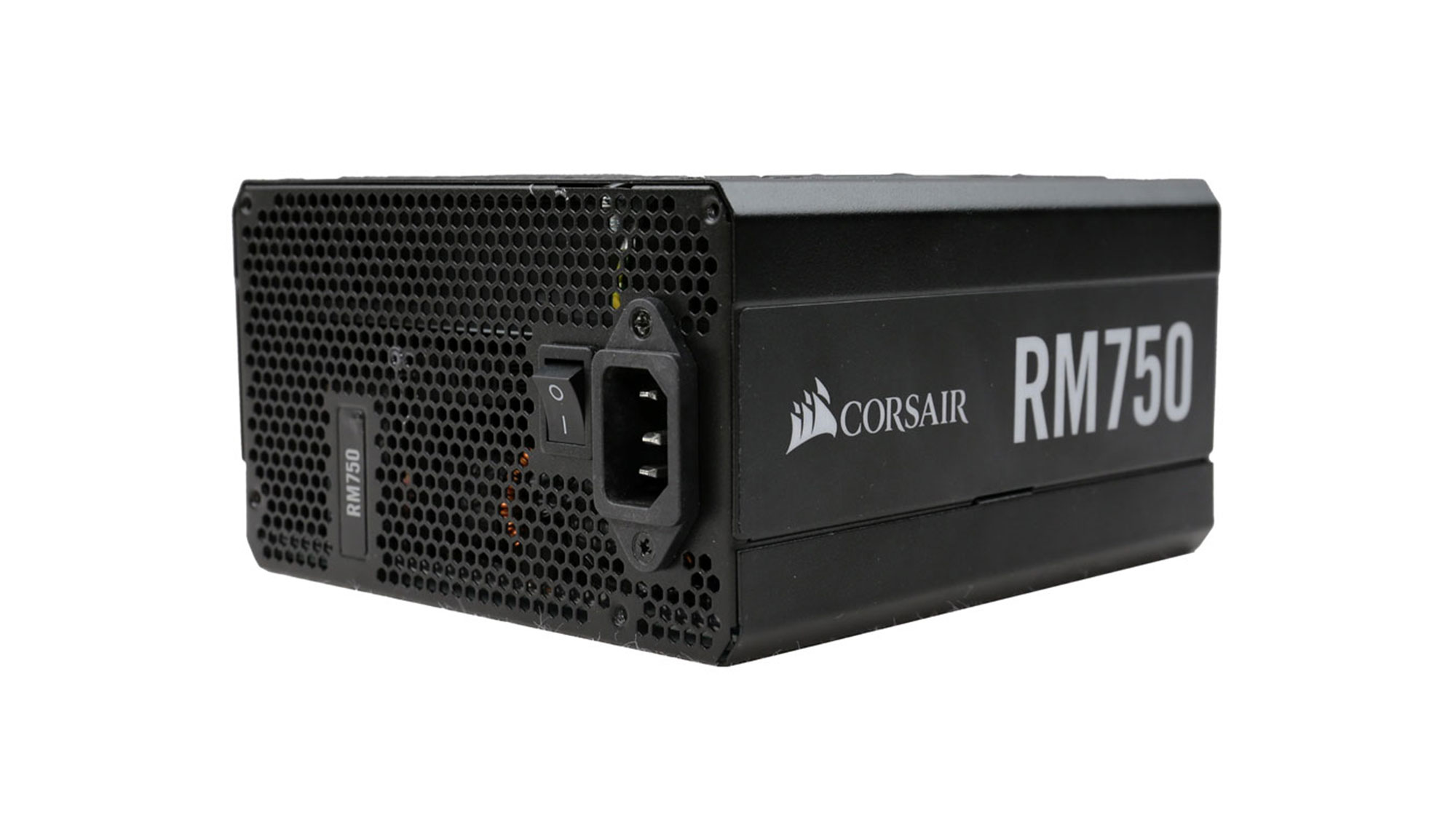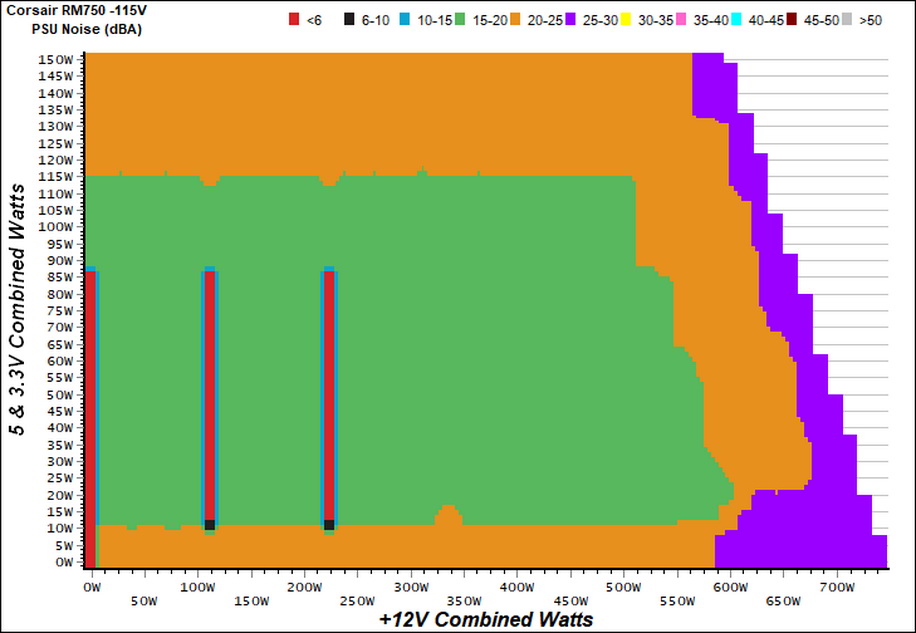Corsair RM750 Power Supply Review: Affordable Yet Powerful
Why you can trust Tom's Hardware
Load Regulation, Hold-Up Time, Inrush Current, Efficiency and Noise
To learn more about our PSU tests and methodology, please check out How We Test Power Supply Units.
Primary Rails And 5VSB Load Regulation
The following charts show the main rails' voltage values recorded between a range of 40W up to the PSU's maximum specified load, along with the deviation (in percent). Tight regulation is an important consideration every time we review a power supply, because it facilitates constant voltage levels despite varying loads. Tight load regulation also, among other factors, improves the system’s stability, especially under overclocked conditions and, at the same time, it applies less stress to the DC-DC converters that many system components utilize.


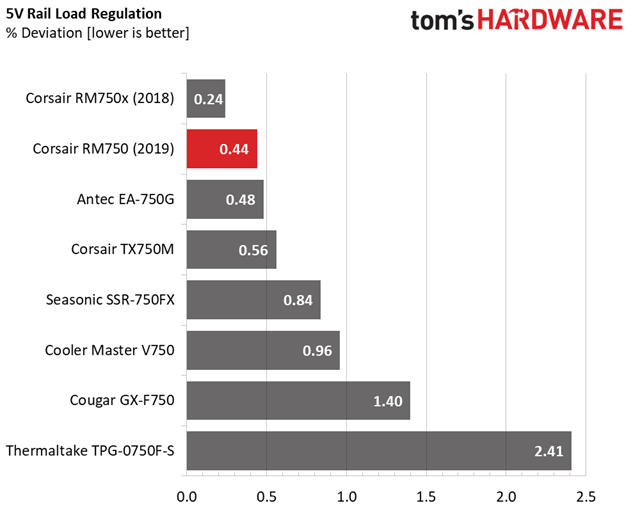
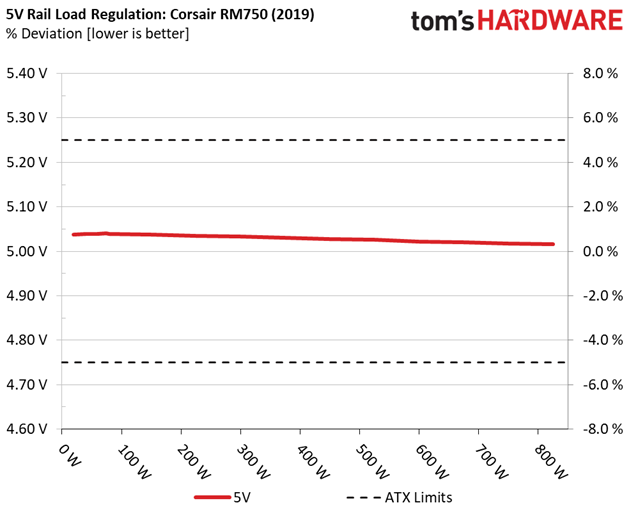




The load regulation is satisfactory at +12V and tight on the minor rails.
Hold-Up Time
Put simply, hold-up time is the amount of time that the system can continue to run without shutting down or rebooting during a power interruption.

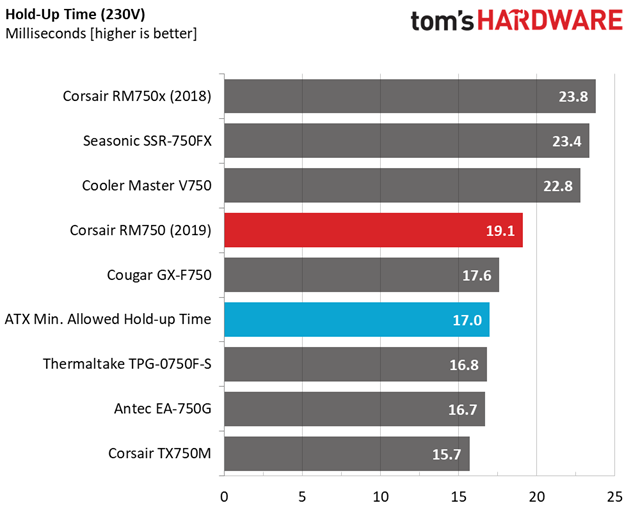



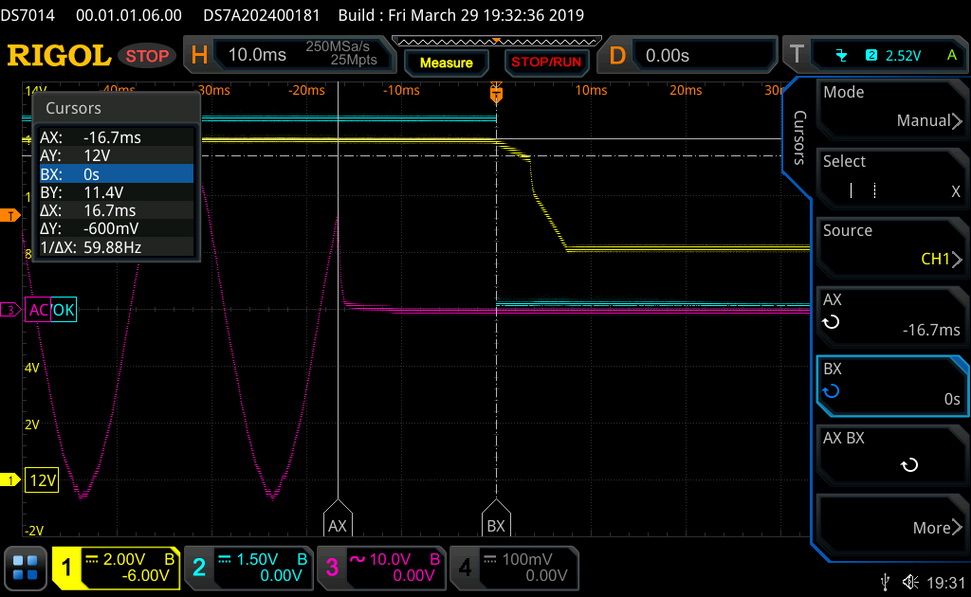

The hold-up time exceeds 17ms, while the power ok signal is accurate.
Inrush Current
Inrush current, or switch-on surge, refers to the maximum, instantaneous input current drawn by an electrical device when it is first turned on. A large enough inrush current can cause circuit breakers and fuses to trip. It can also damage switches, relays, and bridge rectifiers. As a result, the lower the inrush current of a PSU right as it is turned on, the better.


The inrush current is at normal levels with 115V input. With 230V is on the high side, though.
Get Tom's Hardware's best news and in-depth reviews, straight to your inbox.
10-110% Load Tests
These tests reveal the RM750’s load regulation and efficiency levels under high ambient temperatures. They also show how the fan speed profile behaves under increased operating temperatures.
| Test # | 12V | 5V | 3.3V | 5VSB | DC/AC (Watts) | Efficiency | Fan Speed (RPM) | PSU Noise (dB[A]) | Temps (In/Out) | PF/AC Volts |
|---|---|---|---|---|---|---|---|---|---|---|
| 1 | 4.360A | 1.985A | 2.005A | 0.997A | 74.493 | 86.177% | 0 | <6.0 | 42.73°C | 0.974 |
| 12.130V | 5.040V | 3.291V | 5.018V | 86.442 | 39.84°C | 115.12V | ||||
| 2 | 9.778A | 2.979A | 3.010A | 1.197A | 149.392 | 89.931% | 0 | <6.0 | 44.42°C | 0.988 |
| 12.118V | 5.037V | 3.288V | 5.013V | 166.119 | 40.76°C | 115.11V | ||||
| 3 | 15.625A | 3.477A | 3.500A | 1.398A | 224.898 | 91.626% | 0 | <6.0 | 45.61°C | 0.991 |
| 12.089V | 5.035V | 3.286V | 5.007V | 245.451 | 41.07°C | 115.11V | ||||
| 4 | 21.399A | 3.975A | 4.021A | 1.600A | 299.665 | 91.584% | 0 | <6.0 | 46.67°C | 0.993 |
| 12.078V | 5.033V | 3.283V | 5.000V | 327.202 | 41.78°C | 115.11V | ||||
| 5 | 26.864A | 4.972A | 5.029A | 1.802A | 374.613 | 91.076% | 780 | 15.9 | 42.36°C | 0.992 |
| 12.064V | 5.031V | 3.283V | 4.995V | 411.318 | 47.71°C | 115.11V | ||||
| 6 | 32.324A | 5.969A | 6.038A | 2.005A | 449.550 | 90.439% | 781 | 16.0 | 42.84°C | 0.992 |
| 12.057V | 5.028V | 3.280V | 4.989V | 497.076 | 49.23°C | 115.11V | ||||
| 7 | 37.842A | 6.965A | 7.045A | 2.208A | 524.842 | 89.803% | 783 | 16.1 | 44.18°C | 0.993 |
| 12.043V | 5.026V | 3.279V | 4.984V | 584.440 | 51.16°C | 115.12V | ||||
| 8 | 43.338A | 7.967A | 8.058A | 2.412A | 600.169 | 88.985% | 1122 | 28.1 | 44.50°C | 0.994 |
| 12.039V | 5.022V | 3.277V | 4.978V | 674.458 | 52.21°C | 115.12V | ||||
| 9 | 49.212A | 8.468A | 8.546A | 2.412A | 674.684 | 88.241% | 1407 | 34.8 | 45.39°C | 0.995 |
| 12.033V | 5.021V | 3.276V | 4.976V | 764.590 | 53.79°C | 115.12V | ||||
| 10 | 54.905A | 8.970A | 9.071A | 3.026A | 749.954 | 87.314% | 1633 | 39.0 | 46.43°C | 0.995 |
| 12.025V | 5.018V | 3.275V | 4.958V | 858.914 | 55.76°C | 115.12V | ||||
| 11 | 61.186A | 8.974A | 9.075A | 3.028A | 825.176 | 86.487% | 1753 | 40.8 | 46.81°C | 0.995 |
| 12.020V | 5.016V | 3.273V | 4.955V | 954.100 | 57.49°C | 115.12V | ||||
| CL1 | 0.139A | 18.005A | 18.001A | 0.000A | 151.022 | 82.858% | 1007 | 24.6 | 42.50°C | 0.989 |
| 12.116V | 5.015V | 3.280V | 5.070V | 182.267 | 47.74°C | 115.14V | ||||
| CL2 | 62.520A | 1.004A | 1.001A | 1.000A | 765.559 | 87.755% | 1715 | 40.4 | 46.14°C | 0.995 |
| 12.032V | 5.026V | 3.272V | 4.997V | 872.387 | 55.29°C | 115.12V |
The passive operation lasts for quite long if the load on the minor rails remains low. With 20%, 50% and full load the power supply easily meets the corresponding 80 PLUS Gold standard's requirements, even under the high operating temperatures that we apply.
20-80W Load Tests
In the following tests, we measure the RM750's efficiency at loads significantly lower than 10% of its maximum capacity (the lowest load the 80 PLUS standard measures). This is important for representing when a PC is idle with power-saving features turned on.
| Test # | 12V | 5V | 3.3V | 5VSB | DC/AC (Watts) | Efficiency | Fan Speed (RPM) | PSU Noise (dB[A]) | PF/AC Volts |
|---|---|---|---|---|---|---|---|---|---|
| 1 | 1.193A | 0.496A | 0.483A | 0.199A | 19.510 | 80.103% | 0 | <6.0 | 0.829 |
| 12.088V | 5.038V | 3.289V | 5.034V | 24.356 | 115.11V | ||||
| 2 | 2.452A | 0.992A | 1.002A | 0.398A | 39.960 | 85.039% | 0 | <6.0 | 0.936 |
| 12.096V | 5.039V | 3.292V | 5.031V | 46.990 | 115.11V | ||||
| 3 | 3.642A | 1.488A | 1.488A | 0.597A | 59.447 | 86.615% | 0 | <6.0 | 0.963 |
| 12.095V | 5.039V | 3.292V | 5.027V | 68.634 | 115.11V | ||||
| 4 | 4.885A | 1.984A | 2.005A | 0.796A | 79.841 | 86.791% | 0 | <6.0 | 0.975 |
| 12.128V | 5.039V | 3.292V | 5.023V | 91.992 | 115.11V |
High efficiency numbers and minimized noise output, since the PSU's fan is not spinning.
Efficiency
Next, we plotted a chart showing the RM750’s efficiency at low loads, and loads from 10 to 110% of its maximum-rated capacity. The higher a PSU’s efficiency, the less energy goes wasted leading to a reduced carbon footprint, besides lower electricity bills.




The efficiency under light loads is super high.
5VSB Efficiency
| Test # | 5VSB | DC/AC (Watts) | Efficiency | PF/AC Volts |
|---|---|---|---|---|
| 1 | 0.100A | 0.507 | 76.012% | 0.066 |
| 5.063V | 0.667 | 115.10V | ||
| 2 | 0.250A | 1.265 | 77.798% | 0.149 |
| 5.059V | 1.626 | 115.10V | ||
| 3 | 0.550A | 2.778 | 78.563% | 0.260 |
| 5.051V | 3.536 | 115.10V | ||
| 4 | 1.000A | 5.039 | 77.583% | 0.348 |
| 5.039V | 6.495 | 115.10V | ||
| 5 | 1.500A | 7.539 | 77.426% | 0.396 |
| 5.026V | 9.737 | 115.11V | ||
| 6 | 3.000A | 14.958 | 76.653% | 0.457 |
| 4.986V | 19.514 | 115.11V |

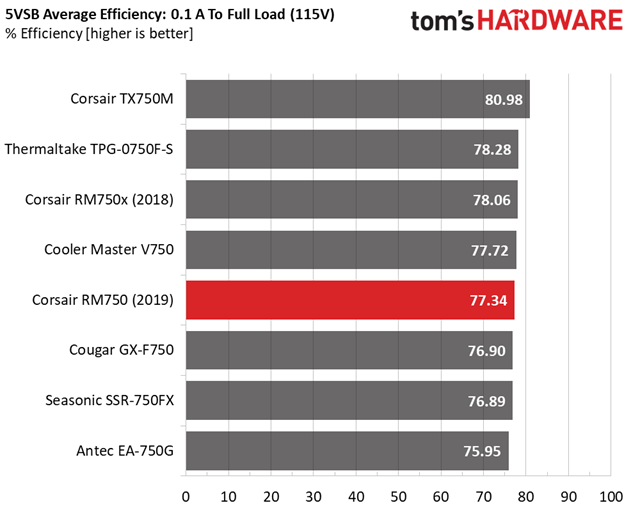
The 5VSB rail is efficient enough.
Power Consumption In Idle And Standby
| Mode | 12V | 5V | 3.3V | 5VSB | Watts | PF/AC Volts |
|---|---|---|---|---|---|---|
| Idle | 12.078V | 5.035V | 3.292V | 5.034V | 3.051 | 0.240 |
| 115.1V | ||||||
| Standby | 0.036 | 0.004 | ||||
| 115.1V |
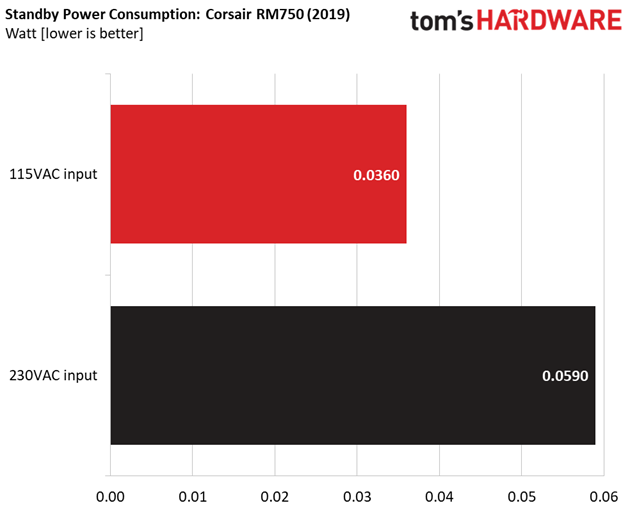

Fan RPM, Delta Temperature, And Output Noise
All results are obtained between an ambient temperature of 37 to 47 degrees Celsius (98.6 to 116.6 degrees Fahrenheit).
With light loads on the minor rails, the unit's passive operation lasts up to 300W loads, even under high operating temperatures.
The following results were obtained at 30 to 32 degrees Celsius (86 to 89.6 degrees Fahrenheit) ambient temperature.
Because we push hard the minor rails (5V & 3.3V), the power supply engages its passive operation only for very short periods. Nonetheless, the fan speed is kept low in general and so does the output noise.
MORE: Best Power Supplies
MORE: How We Test Power Supplies
MORE: All Power Supply Content
Current page: Load Regulation, Hold-Up Time, Inrush Current, Efficiency and Noise
Prev Page Specifications and Part Analysis Next Page Protection Features, DC Power Sequencing, Cross-Load Tests and Infrared Images
Aris Mpitziopoulos is a contributing editor at Tom's Hardware, covering PSUs.
-
DSzymborski It's really hard to recommend this at the price. Offer this at $75 and it's interesting, but there's always something better at this price that'll undercut it and a few additional sales that put under this (SeaSonic Focus, EVGA G3, etc). I don't think this is even competitive at $100.Reply
